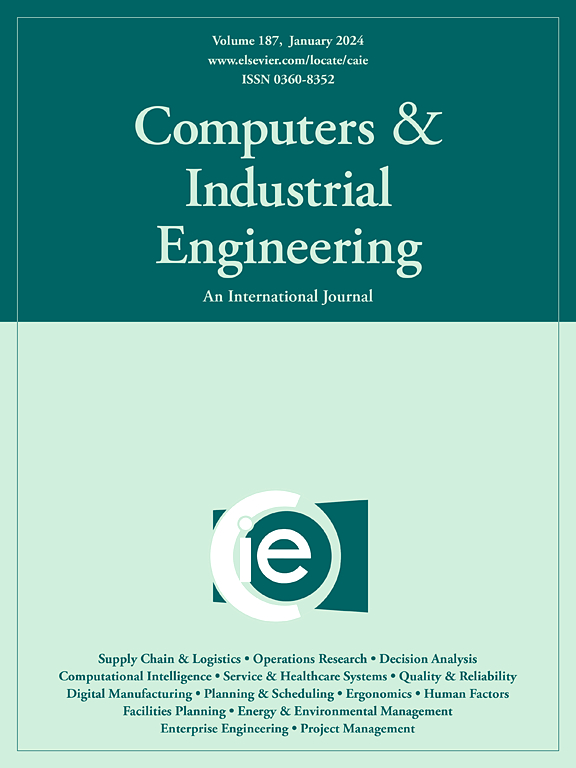考虑换电池的不确定条件下电动摩托车车队动态应急路径问题
IF 6.5
1区 工程技术
Q1 COMPUTER SCIENCE, INTERDISCIPLINARY APPLICATIONS
引用次数: 0
摘要
全球大多数紧急医疗服务(EMS)系统都面临着缩短从事件发生到患者到达的响应时间的挑战。响应病人的需求是高度时间敏感的,导致EMS供应商使用机动车辆。机动救护车携带依赖电池的医疗设备,如自动体外除颤器(aed)。在这种情况下,使用电动摩托车不仅可以保证快速运输,而且可以方便车载医疗设备在整个路线上持续充电。此外,EMS需求是不可预测的,当车辆在提供服务的途中,可能会动态地出现新的请求。因此,动态响应能力变得至关重要。为了解决这些问题,本研究提出了考虑换电池站的电动摩托车车队的MILP动态应急路径问题模型。该模型集成了患者和电池交换站的路径决策,有效地管理响应时间。该模型能够动态接收新的患者需求,并根据信息变化实时更新最优路线。此外,该模型包含了软时间窗,患者服务时间被视为不确定。小尺度问题采用精确方法求解,大尺度问题采用可变邻域搜索(VNS)算法求解。数值实验表明,该算法的求解精度可达98%,运算速度比精确解快得多。结果表明,该模型显著缩短了EMS响应时间,增强了动态响应能力,有效地考虑了不确定性,从而提高了现实条件下急诊医疗操作的有效性和效率。本文章由计算机程序翻译,如有差异,请以英文原文为准。
Dynamic emergency routing problem for electric motorcycle fleets under uncertain conditions considering battery swapping
Most Emergency Medical Service (EMS) systems worldwide face the challenge of reducing response times from the occurrence of an incident to patient arrival. Responding to patient demands is highly time-sensitive, leading EMS providers to use motorized vehicles. Motorized ambulances carry battery-dependent medical devices such as automated external defibrillators (AEDs). In this context, employing electric motorcycles not only ensures rapid transportation but also facilitates continuous charging of onboard medical devices throughout their routes. In addition, EMS demands are unpredictable, and new requests may dynamically occur while vehicles are en route to provide services. Therefore, dynamic response capability becomes critically important. To address these issues, this study proposes a MILP dynamic emergency routing problem model for electric motorcycle fleets considering battery swapping stations. The proposed model integrates routing decisions for both patients and battery swapping stations to effectively manage response time. The model is capable of dynamically receiving new patient demands and updating optimal routes in real-time upon information changes. Furthermore, the model includes soft time windows, and patient service time is treated as uncertain. Small-scale instances are solved using exact methods, while larger-scale problems are addressed through a Variable Neighborhood Search (VNS) algorithm. Numerical experiments demonstrate that the proposed algorithm can obtain solutions with 98% accuracy, operating much faster than exact solutions. The results indicate that the proposed model significantly reduces EMS response time, enhances dynamic response capabilities, and effectively accounts for uncertainty, thereby improving the effectiveness and efficiency of emergency medical operations in realistic conditions.
求助全文
通过发布文献求助,成功后即可免费获取论文全文。
去求助
来源期刊

Computers & Industrial Engineering
工程技术-工程:工业
CiteScore
12.70
自引率
12.70%
发文量
794
审稿时长
10.6 months
期刊介绍:
Computers & Industrial Engineering (CAIE) is dedicated to researchers, educators, and practitioners in industrial engineering and related fields. Pioneering the integration of computers in research, education, and practice, industrial engineering has evolved to make computers and electronic communication integral to its domain. CAIE publishes original contributions focusing on the development of novel computerized methodologies to address industrial engineering problems. It also highlights the applications of these methodologies to issues within the broader industrial engineering and associated communities. The journal actively encourages submissions that push the boundaries of fundamental theories and concepts in industrial engineering techniques.
 求助内容:
求助内容: 应助结果提醒方式:
应助结果提醒方式:


